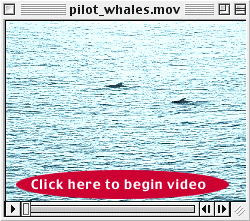|
|
  TODAY'S WEATHER Partly Cloudy 84.2°F (29°C) Latitude: 2 deg 7’N Longitude: 97 deg 26’W Wind Direction: E Wind Speed: 6 Knots Sea State: 1 Swell(s) Height: 3-5 Foot Sea Temperature: 84.2°F (29°C) Barometric Pressure: 1010 MB Visibility: 10-25 Nautical Miles  Breakfast Ham & Cheese Omelet French Toast Pound Cake Bacon & Sausages Hash Browns & Hot Cereal Eggs to Order Fresh Mangoes and Melon Dry Cereal Juices Lunch Cheese Burgers French Fires Minestrone Soup Salad Bar Fresh “Aku” Tuna Sashimi Pumpkin Bars Dinner Roasted Pork Loin Mashed Potatoes w/Gravy Beets and Broccoli Fresh “Aku” Tuna Sashimi Salad Bar Blueberry and Cream Cheese Blintz Homemade Vanilla Ice Cream  Click here to see pilot whales swimming next to RV Melville. Surveys and visitors at the Galapagos Rift For the last time on this expedition, we have begun our detective work to find a young volcanic eruption -- this time at the Galapagos Rift. We arrived here at 0047 hours local time, or 0647 hours GMT (Greenwich Mean Time) today -- how does that match your calculation based on the information I gave you yesterday? The first step in collecting evidence -- our multibeam bathymetry survey -- took about seven hours. Just after breakfast, we were at the launch position for the start of the DSL-120 sonar survey. Calm seas helped the DSL-120 sonar launch this morning go smoothly. If all goes as planned, in about 2.5 days, we will have a detailed sonar image of the 4.5 kilometer-wide rift valley where spreading is separating the Cocos Plate from the Nazca Plate to the south. Each of our sonar survey lines is about 20 nautical miles, or 37 kilometers, long. It will take us about 12.5 hours to run each line. Can you calculate what speed we are towing the DSL-120 sonar fish? (Hint: look at the March 25th Daily Journal for information on calculating speed if you know the time and the distance.) We will post the answer in tomorrow’s Daily Journal along with some images of the sonar data we have collected so far. This afternoon, we were busy with visitors! Several pods of short-finned pilot whales came by. They dove and surfaced around the ship for about 15 minutes before they swam away. Then, about mid-afternoon, we were buzzed by a small helicopter, like the ones used by tuna boats to scout for schools of fish. A short while later, we spotted two fishing vessels coming over the horizon. One of the ships, the Maru#18, was a Japanese long-liner (a ship that uses long lines of baited hooks to catch large, open ocean fish like tuna). They had strung their fishing line out in front of the RV Melville. Not the best of situations while we were towing the DSL-120 sonar system! We were able to raise the Maru#18 on the radio, and they kindly recovered their fishing line before we crossed over it. It was good to have company, even briefly, out in the middle of the ocean! Dan Engelbrecht’s Dynamite Parmesan Wahoo Everyone loved the way Dan Engelbrecht prepared the fresh Wahoo we had for dinner last night. We have the “Dave’s” to thank for hauling it in, but Dan tickled our taste buds last night with his “Parmesan Wahoo” recipe. Here it is for you all to enjoy. Ingredients: 1) In a bowl, mix equal amounts of cheese and mayonnaise. Add white wine to thin the mixture into a batter consistency. Add dill weed (fresh if possible) to taste. Make enough to coat all sides of the Wahoo generously. 2) Cut the Wahoo into 2 inch thick pieces, removing all skin and bones. 3) Lightly grease a glass or stainless baking dish that is large enough for all the fish pieces. 4) Take the sliced onions and cover the bottom of the baking dish. 5) Dredge the Wahoo in the batter and place on top of the onions in the baking dish. 6) Bake at 400°F for 20-25 minutes or until the top of the fish is golden brown and the fish flakes easily. 7) Serve immediately with wedges of lemon for garnish. 8) Eat and enjoy!
|
|||||||||||||||||||||||||||||||||||||||||||||||||||||||||||||||||||||||||||||||||||||||||||||||||||||||||||||||||||||||||||||||||||||||||||||||||||||||||||||||||||
© 2010 Dive and Discover™. Dive and Discover™ is a registered trademark of
Woods
Hole Oceanographic Institution
